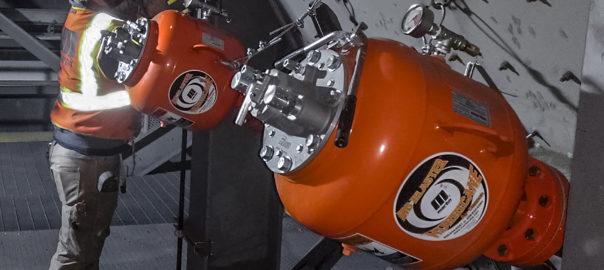Martin Engineering, a leader in industrial bulk handling, has helped Lundin Mining’s Eagle Mine in Michigan’s Upper Peninsula with clogging and downtime issues, resolving these problems and improving material flow with powerful and compact air cannon technology.
Martin Engineering installed the cannons in a chute carrying damp fines through the refining process at Eagle, with the cannons mitigating blockages and facilitating the movement of material. The result was improved safety, reduced labour costs, greater production, less downtime and a calculated circa-1,000% saving to the cost of operation over existing solutions.
“Safety is a top priority for us,” Ted Lakomowski, Lead Reliability Technician at Eagle Mine, said. “When we experienced clogging and downtime at the processing mill, our crew naturally swung into action to resolve it, but we immediately sought a safer long-term solution.”
Eagle Mine is the only primary nickel mine in the USA, producing 1.5% of the world’s total nickel production. The company extracts approximately 2,000 t/d from the underground nickel-copper mine using a bench-and-fill stoping process. Ore from the mine is stored in a covered coarse stockpile facility prior to transport to the Humboldt Mill. A former iron ore processing plant, the Humboldt facility’s three-stage crushing circuit reduces the material to 3/8 in-minus (9.5 mm-minus), then a single stage ball mill grinds it further and it is mixed into a slurry.
To liberate the nickel and other minerals from the waste materials, a refining process of selective flotation is used. During the crushing process, a mesh screen separates the fines from the remaining aggregate, which are fed back through the process. Fines that pass through a screen fall into a wide-mouthed hopper, leading to a chute that narrows to approximately 2.5-m wide by 0.6-m high and – after a dead drop of several feet – slopes in a circa-45º of decline. This slope slowed the descent of the fine material for a low impact and centred discharge onto a conveyor belt leading to the ore bins. Material buildup began at the hopper and at the discharge slope, but could also occur at virtually any point, blocking the chute, according to Martin Engineering.
Such accumulation would stop the entire crushing process approximately three-to-four times per shift for as long as an hour, blocking input of material all the way back to the ore storage area. Workers attacked the clog with 4.5-m long air lances from the top of the hopper and bottom of the chute. The method used a tremendous amount of compressed air and diverted manpower from other essential duties. Moreover, air lances caused excessive splash-back of wet material, which was extremely messy and potentially hazardous.
Eagle first installed a polymer lining in the chute. Offering a low coefficient of friction, the lining was bolted to the chute wall and acted like a smooth slide for the material to ride down. Less effective against the adherent qualities of the material than hoped, Eagle next installed pneumatic vibrators onto the vessel wall, intended to agitate the adhered material and promote its descent down the chute slope. But the fact that the polymer lining was bolted to the vessel caused it to dampen the vibration of the units, limiting the force to only the impact zone and not much farther.
“We were forced to default back to air lances, but kept on looking for a better solution,” Lakomowski explained. “Having worked with Martin Engineering in the past, we asked them to come in, examine the issue and offer a safe, effective and affordable solution.”
Lakomowski advocated for the initial installation of five 35 litre Martin® Hurricane Air Cannons, followed by two more placed in essential spots in the chute. One unit was placed at the area where material discharged into the hopper, two others were positioned at the hopper slope where the most accumulation was observed and two more were placed along the drop chute. All of the tanks were accompanied by a 101 mm pipe assembly ending in fan jet nozzles.
Offering more force output than designs double their size with considerably less air consumption, the compact air cannon tanks measure only 406 mm in diameter 633-mm long, weighing 35 kg each, Martin Engineering says. The units fire a shot of air at up to 120 psi (8.27 bar) through the pipe assembly to a fan jet nozzle. The nozzle spreads the air stream 304 mm at the exit point, distributing the blast pattern across the surface of the wall.
Operating on a regular firing schedule of every 1-10 minutes – readjusted for production volume, time of year and moisture level – revealed the seven-cannon configuration reduced clogging issues and downtime, according to the company. This significantly lowered the risk to operators and reduced the cost of operation.
“When I did the cost assessment, I was surprised to discover that there was a 1,000% compressed air savings in using the air cannons over the air lances,” Lakomowski said. “It’s a significantly lower effect on our system than initially predicted, and managers are very happy about that.”
The project also improved safety, as workers spent less time diverted from other assignments to use air lances or create vibration by beating on the vessel walls, Martin Engineering said. By being able to perform maintenance on wear parts like valves from the outside of the cannon without tank removal, upkeep can be safely performed by a single technician with no heavy lifting involved, it added.
“Just from a safety aspect, this solution has paid for itself,” Lakomowski concluded. “The Martin Engineering team was easy to work with, and they were cognisant of our budget restrictions. Overall, this was a successful project.”







